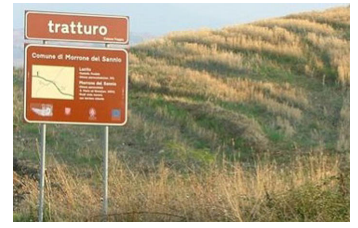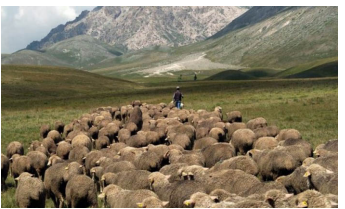ALONG THE SHEPHERD’S TRACKS: TRATTURI AND TRANSUMANZA
[Note: Italy is seeking to have transhumance, the traditional herding of livestock along centuries-old migration routes, added to the United Nations Educational, Scientific, and Cultural Organization’s (UNESCO) list of intangible cultural heritage. Italy submitted the bid with the backing of Greece and Austria, the Italian Ministry of Agriculture announced recently. UNESCO’s decision is expected in November 2019. Source: THE LOCAL it, March 27, 2018].
People who have had the pleasure of visiting Abruzzo and Molise, traveling on state or rural roads connecting villages and towns, have noticed something new – occasional markers placed on the shoulder of these roads reminding travelers that they are approaching a “tratturo”, or tracks not easily discernible, that, over time, formed paths in the seasonal migration of sheep and other animals, referred to as the “transumanza”. The term derives from the Latin words “trans” (across) and “humus” (ground). Each marker provides a graphic description and history of a particular “tratturo”.
Since ancient times, the story of Abruzzo and Molise and its people, going as far back as the Samnites and the Romans, has been shaped in large measure by the harsh mountainous character of their territory. Abruzzo has two of the highest peaks in the Apennine mountain range - the Gran Sasso, at an altitude exceeding 9,000 feet, and La Majella, to the south, over 6,000 feet. In Molise, there is the Matese mountains, with elevations of over 4,000 feet. For some 3,000 years, the territory of these two regions and its people has been continuously conditioned by the traditions and life-style of sheep-rearing communities. The high altitude, valleys, rocky slopes and bleak, barren mountainous plains have been an ideal environment for sheep grazing.
For centuries, sheep-rearing provided a livelihood for more than half of the population of Abruzzo and Molise, and from pre-Roman times, it constituted the basis of their economy, social fabric and culture. Sheep-rearing also provided the regions with characteristics and the earliest routes for travel and communication. An important part of this form of social development was the exploitation of the terrain for grazing – high altitude, green pastures prevalent in the regions (not suitable for grazing in the winter - too cold), were lush green with grass in the summer. In contrast, the low-lying grasslands south of these regions, in Puglia and to a lesser extent Campania and Lazio, provided excellent conditions in the winter months. These ideal conditions gave rise to transumanza, the seasonal migration of people and animals during different seasons of the year (spring and summer in the highlands of Abruzzo and Molise, and in the fall and winter in the regions to the south). These annual migrations occurred along a regulated system of wide grassy tracks, known as “tratturi”. Historical research that continues to this day has identified five main tratturi in the regions: L’Aquila-Foggia; Centarelle-Montesecco; Celano-Foggia; Pescasseroli-Candela; and Ateleta-Biferno.
These “tratturi” were about 350 to 400 feet wide and extended for distances of 250 to 300 kilometers, connected to inland areas of Abruzzo and Molise. The “tratturi” followed well-developed routes, established over centuries of regular use. From the Roman Period onward, and, in particular, during the reign of the Aragonese, these routes were rigidly determined and legally protected by edicts issued by governors of the regions.
The phenomena of the transumanza were not unique to Italy. They developed and were practiced in many parts of Europe. Although there were cultural and technical differences, the underlying practice of taking advantage of remote seasonal pastures was similar. My wife Edvige and I observed this form of seasonal migration, on a smaller scale, hiking the Swiss Alps, while living in Geneva, Switzerland. In Switzerland, this form of migration was and still is prevalent with the rearing and grazing of cattle, which are taken during the spring and summer to pastures in higher elevations of the Alps (8,000 to 10,000 feet), and to the lower valleys in the winter. A unique experience during those hikes was to hear in the distance the sound of cow bells. The cows were left to graze for days, and the bell served as a sort of GPS, to locate the cows for the daily milking. Growing up in my native village of Roccamandolfi, located in the foothills of the Matese range, a rather wealthy family owned thousands of sheep that grazed in the high-altitude plateaus and valleys of the Matese. With the approach of winter, the sheep were herded through our village on their way to Puglia. The stench left behind by the sheep as they moved through the village was awful!
Turning to Abruzzo and Molise, the stability for the seasonal movement of flocks between the two regions and Puglia was provided by the institution of laws, the “Agraria Epigraphis” (Agrarian laws) instituted by the Romans, designed to regulate the use of public grazing lands and routes for the movement of livestock through “calles”, later known in Italian as “tratturi”. During the Middle Ages, seasonal migration came practically to a halt, due to political destabilization and feudal conflicts, making the “tratturi” unsafe. “Transumanza” surfaced again under the Normans in the 1,000 to 1,100 centuries and in particular under the influence of the Benedictine monks. In Abruzzo, it was the Benedictines who had the greatest impact on the social, economic and cultural development of the region. The Benedictines contributed greatly to the promotion of raising sheep, making the region Europe’s leading producer of wool. The intrusion of government regulation on such successful enterprises surfaced under the rule of the Spanish King, Alfonso I of Aragon, who established in Foggia a “dogana”, or custom house, used for the collection of taxes and duties from the use of the “tratturi” and grazing rights for sheep. Regulations were also established as to the time of the year the livestock was permitted to migrate. In early May, all forms of livestock migrated to the Apennine pasture, whereas the migration to the south, toward Puglia, was more diversified: sheep and goats migrated to Puglia in midSeptember and cattle in mid-December. For a sense of the incredible numbers of sheep that grazed in Abruzzo in years past, research suggests that as many as 3 million sheep were grazing in the pastures of Abruzzo.
In the beginning of the 15th to 16th century, sheep-rearing began to decline, accelerated by a shift in land use from grazing to farming, as laws were enacted to encourage the growing of crops. The economic transformation began to destroy the traditional interdependent system of agriculture and sheep-rearing on which the economies of the two regions had been based for centuries. Many villages that once were mainly devoted to the raising of sheep, wool, cheese, etc., began to be de-populated and in some cases were abandoned all together.
The main economic activity of Abruzzo and Molise, which for centuries shaped the regions’ lifestyle and culture, has left its mark on the territory. A concerted public appreciation and awareness of the “traturri” has given an impetus to restore their historical significance to the regions’ rich cultural heritages. They offer unique tourist attractions for trekking and horseback riding that has become very common in recent years. Interesting enough, it was a German tourist who took an interest, learning more about “tratturi” and “transumanza” and encouraged the two regions to rediscover this heritage.
Let me offer some brief observations on the shepherds, these sturdy, dedicated men who cared for the animals. During the seasonal migration, shepherds would walk hundreds of kilometers in the company of their livestock, a walk that would average three weeks or more to reach the grazing pastures. The shepherds were obliged to share their living conditions with their flocks; a rugged life, lived in isolation, in the open, physically bound to the caring of their flocks for 10 to 11 months out of the year, and conditioned by the grazing needs of their flocks and available pastures. The diet of the shepherds was very simple and austere. Bread (not the kind we enjoy today) was essential to sustain them, complemented by herbs and vegetables, such as cicoria, rugola, onions, and plenty of salt and cheese. Besides a meager wage, shepherds were given a kilo of bread daily, some of which they could exchange for 50 kilos of grain, a kilo or salt and a liter of oil. In one of our frequent visits to Roccamandolfi, we went on a hike to Campitello del Matese and ran into a shepherd caring for a flock of sheep. We stopped and initiated a conversation. We learned that he had emigrated from Macedonia. We were told by village elders that Macedonians make the best shepherds: they are reliable, and they do not mind the harsh life and isolation. A faithful companion of these shepherds is the sheep dog or mastiff, which Abruzzo claims is the best breed in the world. These dogs have a natural instinct to protect sheep and other animals against predators. These dogs are easily trained to control the movement of sheep.
The famous Abruzzese poet, Gabriele D'Annunzio, wrote “I Pastori”, a short poem about the transumanza included in the collection Alcyone - Sogni di terre lontane (composed between 1903 and 1907).
I Pastori
Settembre, andiamo. È tempo di migrare. Ora in terra d'Abruzzi i miei pastori lascian gli stazzi e vanno verso il mare: scendono all'Adriatico selvaggio che verde è come i pascoli dei monti.
Han bevuto profondamente ai fonti alpestri, che sapor d'acqua natia rimanga né cuori esuli a conforto, che lungo illuda la lor sete in via. Rinnovato hanno verga d'avellano.
E vanno pel tratturo antico al piano, quasi per un erbal fiume silente, su le vestigia degli antichi padri. O voce di colui che primamente conosce il tremolar della marina!
Ora lungh'esso il litoral cammina La greggia. Senza mutamento è l'aria. Il sole imbionda sì la viva lana che quasi dalla sabbia non divaria. Isciacquio, calpestio, dolci romori.
Ah perché non son io cò miei pastori?
The Shepherds
Translated by Omero Sabatini, AMHS Member
September. Let's go. This is the season of migration Now in the land of Abruzzo my shepherds Leave behind the [sheep] pens and head for the sea They go down to the Adriatic [Sea] Which is as green as the pastures of the mountains.
They have drunk repeatedly from the springs at the high elevation, so the taste of the water of their native land May remain in their exiled hearts And may long delude their thirst along the way Have carved a new staff from [a branch] of a filbert tree
And follow the ancient pathway toward the lowland As though [floating] on a silent river made of grass, In the tradition of their ancestors of old Oh the exclamation of the one who is the first To sight the rippling sea!
Now along the very littoral walks The flock. The air is absolutely still. The sun tinges the moving wool with such a blondish hue Almost the same as that of the sand. Lapping of water, pattering of hooves, sweet sounds.
Ah why am I not with my shepherds?



